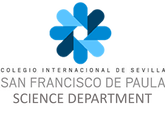10º Biology and Geology Minimum Contents Year 2014-2015
Note: All minimum contents can be used to ask reasoning questions as knowing them implies understanding them.
1st Evaluation
1. Definition of: gene, homologous chromosomes, allele, homozygous(true-breed), heterozygous (hybrid), complete dominance, codominance and incomplete dominance, genotype and phenotype.
2. Genetic problems.
3. Drawing of a nucleotide including all of its components.
4. Structural and functional differences between DNA and RNA.
5. Differences between transcription and translation.
6. Structure and function of the cell nucleus.
7. Concept and phases of the cell cycle.
2nd Evaluation
1. Concept of Mitosis. Name each phase and type of cells that undergo this process.
2. Concept of Meiosis. Name each phase and type of cells that undergo this process.
3. Sources of genetic variability of meiosis1. Interpretation of Mendel´s laws.
4. Concept of linked genes.
5. Concept of mutation.
6. Concept of genetic engineering and its purposes.
7. Name practical applications of genetic engineering.
3rd Evaluation
1. Concept of: spontaneous generation, chemical evolution theory, Creationism, doctrine of fixed species and evolution
2. Main flaw of Lamarck’s theory of evolution.
3. Darwin`s theory of natural selection as the main new mechanism of evolution.
4. Today’s theory of evolution.
5. Name 3 types of proof we have for the evolution theory
6. Concept of ecosystem.
7. The complete definition of Species.
8. Classify and list the environmental factors of an ecosystem.
9. Concept and name of trophic level.
10. Trophic parameters of an ecosystem: biomass, productivity and ecological pyramids.
11 Understand and explain why in an ecosystem the flow of energy is not cyclic while the flow of matter is a cyclic process.
Note: All minimum contents can be used to ask reasoning questions as knowing them implies understanding them.
1st Evaluation
1. Definition of: gene, homologous chromosomes, allele, homozygous(true-breed), heterozygous (hybrid), complete dominance, codominance and incomplete dominance, genotype and phenotype.
2. Genetic problems.
3. Drawing of a nucleotide including all of its components.
4. Structural and functional differences between DNA and RNA.
5. Differences between transcription and translation.
6. Structure and function of the cell nucleus.
7. Concept and phases of the cell cycle.
2nd Evaluation
1. Concept of Mitosis. Name each phase and type of cells that undergo this process.
2. Concept of Meiosis. Name each phase and type of cells that undergo this process.
3. Sources of genetic variability of meiosis1. Interpretation of Mendel´s laws.
4. Concept of linked genes.
5. Concept of mutation.
6. Concept of genetic engineering and its purposes.
7. Name practical applications of genetic engineering.
3rd Evaluation
1. Concept of: spontaneous generation, chemical evolution theory, Creationism, doctrine of fixed species and evolution
2. Main flaw of Lamarck’s theory of evolution.
3. Darwin`s theory of natural selection as the main new mechanism of evolution.
4. Today’s theory of evolution.
5. Name 3 types of proof we have for the evolution theory
6. Concept of ecosystem.
7. The complete definition of Species.
8. Classify and list the environmental factors of an ecosystem.
9. Concept and name of trophic level.
10. Trophic parameters of an ecosystem: biomass, productivity and ecological pyramids.
11 Understand and explain why in an ecosystem the flow of energy is not cyclic while the flow of matter is a cyclic process.

